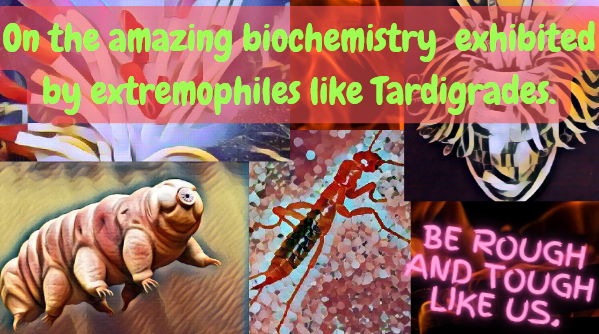On the Biochemistry of Extremophiles Like Tardigrades
Sibsankar Palit
The biggest challenge to life on Earth that prevents it from moving beyond our own planet Earth is the impact of space on its metabolism and physiology. Many germs and microscopic animals exhibit amazing biochemistry that helps them survive extreme heat, extreme cold, extreme radiation and extreme space conditions and thus they are called extremophiles (like tardigrades). Tardigrades, water bears or chubby bears are extremely resilient microscopic animals that can survive dehydration (water is essential for maintenance of cellular metabolism and all biochemical reactions in all cells in the body of a living organisms) for decades, and can even survive on exposure to extreme heat, extreme cold, extreme radiation and extreme space conditions.
According to the understanding of scientists regarding tardigrades, they undergo a process called ‘Anhydrobiosis’ (Greek: life without water) where they enter a so-called ‘tun state’ where they drag their head and eight legs into their body and curl up into balls, and remain in that state until they get rehydrated. It is thought that in the ‘tun state’, tardigrade cells begin to synthesize special molecules to combat the lack of water and form a matrix in the cell. When rehydrated, the matrix gets dissolved and it leaves behind undamaged functional cells. Not only tardigrades, but also many bacteria, single-celled organisms, brine shrimp and plants like Sellaginella leppidophylla can survive dehydration. Tardigrades are found on all continents of the world, including Antarctica. Tardigrades are also found in lichens in our yards and forests; all it takes is a simple compound microscope to see those tardigrades and a little patience while finding them.
Scientists are trying to find out if tardigrades really undergo the ‘tun state’. Understanding this biochemical phenomenon can help scientists stabilize sensitive biomolecules, create stress resistant crops to combat climate change, and even improve the health of astronauts and, above all, help us understand whether there can be a possibility of life on planets less habitable than our Earth.
References:
1.Boniato Studio. (n.d.). TED-Education – Meet the Tardigrade, by Thomas Boothby. [online] Available at: https://www.boniato.studio/ted-education-meet-the-tardigrade [Accessed 2 Mar. 2022].
2.Journey to the Microcosmos (2019). Tardigrades: Chubby, Misunderstood, & Not Immortal. YouTube. Available at: https://www.youtube.com/watch?v=kux1j1ccsgg.





